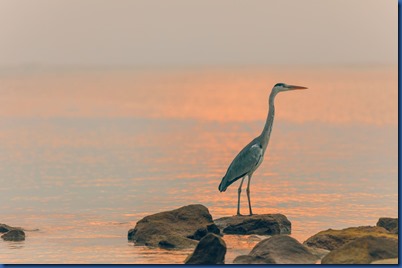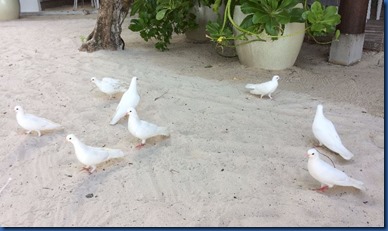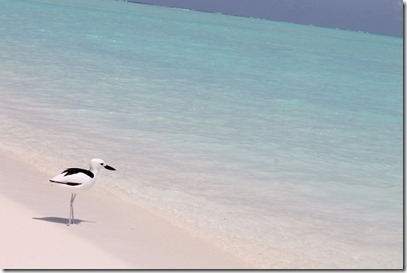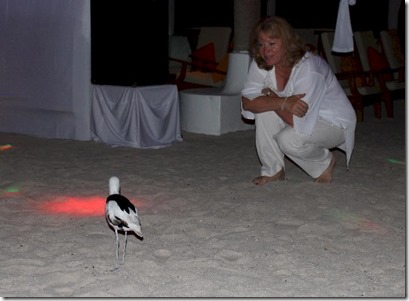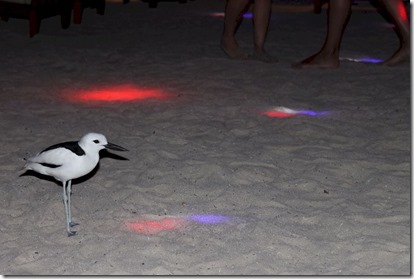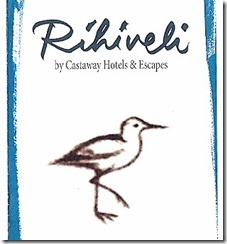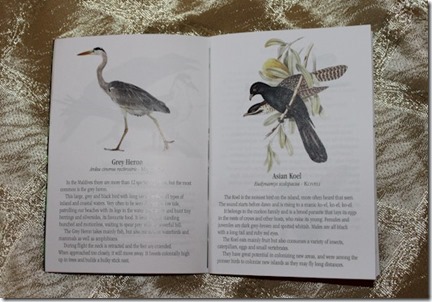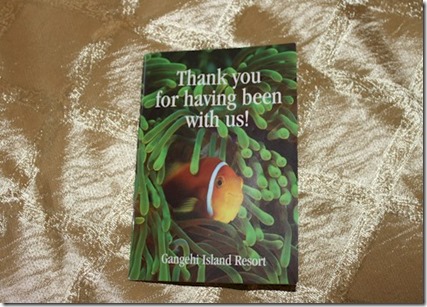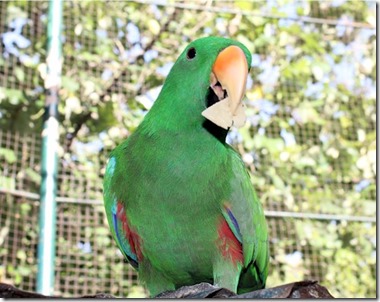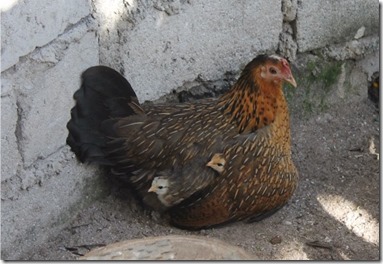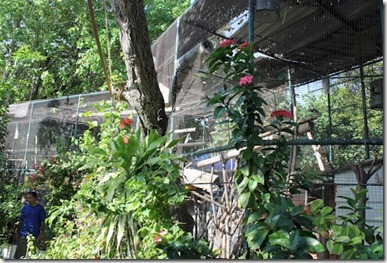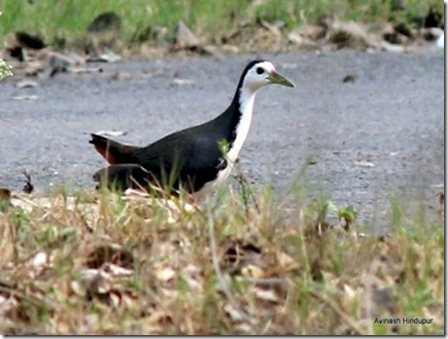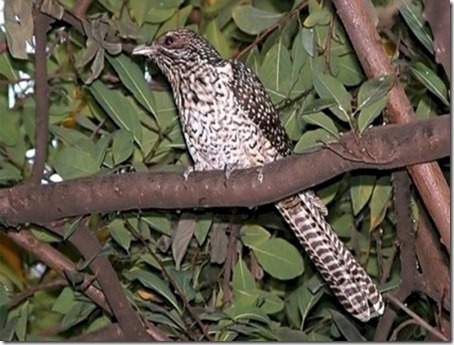Every resort island seems to have a few resident herons who have staked out their territory in the shallows patiently waiting for the wayward bait fish to nab and otherwise strolling with an uncommon deliberation. But, if you wonder where they come from, LUX North Male Atoll actually has a heron nesting site. The construction of the property preserved the site where at least 10 resident herons come to birth their chicks on a secluded part of the island that is cordoned off from guests (a little privacy in the marine maternity ward).
Best of the Maldives: White Doves – Malahini Kuda Bandos
Of all the resort resident birds, perhaps none are more apropos that the flock of white doves on Malahini Kuda Bandos. Releasing white doves is can be found at some of the more extravagant wedding celebrations. And they are an iconic symbol of peace. Like the tranquillity you find sitting among them at the beach bar watching the sunset.
Best of the Maldives: Crab Plover – Rihiveli Beach
Resorts feature all sorts of resident creatures including turtles, cats, octopi and rabbits. Many islands host a bevy of birds. But no resident has charmed us as much as “Julietta” at Rihiveli Beach.
Julietta is Rihiveli’s resident Crab Plover. The local story goes that she was found on the neighbouring bird island when the resort was first developed in 1983 and brought over to Rihiveli because she couldn’t fly. Obviously, 34 years is a long life for a bird so there is speculation that this “Julietta” arrived in 2006 after the tsunami hit.
Whatever her back story, her present day exploits are downright captivating. She came right up to us and greeted us sitting on our lounge chairs soon after our arrival. She follows the staff around like a puppy and at one point strolled along with us when a staff member was taking us some place. At first we thought that she was looking for food handouts or droppings, but it turns out she’s not interested human food in the least. All she eats are the little crabs that run across the beach. Actually, the staff can (and do) help her with her meals by shining a torch on the beach when the crabs are most active which helps Jullietta spot them. During a beach dinner one night, Julietta was being particularly sociable and so one of the chefs decided that she deserved some of her own treats. He stepped away from the buffet, turned the flashlight on his iPhone and shined it on the sand while Julietta eagerly snapped up a meal of unsuspecting micro-crustaceans.
But the most fun part of the night was her joining the crowd on the disco floor of the infamous Rihiveli White Party (see photos below). During the thumping house music, she was out there in centre of the dance floor seemingly enjoying the vibe as much as any guest.
Julietta has inspired her own virtual fan club with lots of paparazzi shots of her by visitors posted on TripAdvisor and Flickr. She has become such a high profile part of the property that the resort logo features her (in the midst of some of her disco dancing maybe) – see photo at bottom.
Maldives QI – Part Nine for N
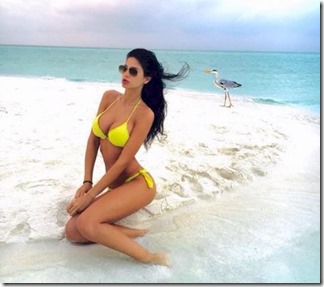
This bird is not attractive in the way you might think…
Q: The “Makana” bird (heron) is found everywhere in the Maldives (each resort seems to have its own resident). What makes it such a good fisherman?
A: The Heron making his own oil secreted from the toes which attracts fish.
Q: Buuzzzzz! No. The “stinky feet” story about herons turns out to be an old wives tale (or old fishermans tale)
“Fishermen of yore were convinced that a heron’s foot exuded oil that enticed fish within range of the bird’s five-and-ahalf-inch serrated beak. A formula from the year 1740 for a witches’ brew, Unguentum Piscatorum Mirable, to be smeared on fishing lines included heron’s fat as well as cat’s fat and ‘Man’s fat [which] you may get of any surgeons who are concerned in anatomy.’ To debunk this myth for his 1954 book on the grey heron (spelled ‘gray’ in this country), the Old World counterpart of our great blue heron, British naturalist Frank A. Lowe dropped heron’s-foot extract in an aquarium. The fish ignored it.” – National Wildlife Federation
QI Series N should be hitting our screens in a few weeks time. “N” as in “noisome nippers” perhaps.
Best of the Maldives: Nature Guide Book – Gangehi
One of the first things that I do when I arrive at a hotel room is to gather all of the marketing literature sprinkled liberally around the room and move it to some out of the way place. Lots of glossy material with pictures of palm trees and pina coladas that are not that interesting to me.
But Gangehi has created a booklet that was so good I brought it home. It is a guide to the plants and animals found on the resort. Fish guides are quite popular in the gift shops, but this is more land focused. The tropical life on the land has its own intriguing variety, colour and distinction. It’s great to have such a handy guide. You can buy natural guide books, but most cover the entire Indian Ocean and therefore are quite heavy (taking up precious luggage weight). Also, they tend to be so comprehensive it is often hard to find the particular creature you are seeking. Gangehi’s guide is limited to those critters found on the island itself so it is quite concise.
Beach reading!
Best of the Maldives: Aviary – Chaaya Reef Ellaidhoo
Colourful creatures floating all around you. Some inquisitive about your presence, while others more skittish and shy. Large and small, or all shapes and colours. Not the marine life in the water, but the bird life in the air on Chaaya Reef Ellaidhoo. Elaidhoo features an expansive aviary filled with fowl of all description – parrots, exotic hens, cockatoos [OTHERS]. As colourful as any collection of tropical fish you will find in the water.
We took as many pictures visiting the aviary as we did on any house reef. But my wife Lori’s favourite (so much so that she changed her Facebook profile picture to it) was of the baby chicks who hid in their mother’s wings and poked their heads out (see bottom).
Best of the Maldives: Twitchers – Sun Island
Another sanctuary for the airbourne is Sun Island’s Kovelivaa park, the biggest bird sanctuary among the Maldives resorts.
As it happens, today is Audubon Day established on the birthdate of the world’s leading ornithological illustrator, John James Audubon. Sometimes, Audubon Day (celebrating wild fowl) and Arbor Day (celebrating wild foliage) are celebrated together by planting trees in bird sanctuaries like Sun’s.
There is more to the Maldives fowl than herons (it seems as it every resort has its resident heron who combines stalking the lagoon shallows for fish with posing like a fethered statue for hours on end to charm the guests). Two lesser seen examples of Maldive bird life found on Sun Island are described below by the resort…
White Breasted Waterhen (Amaurornis phoenicurus) – “These white breasted waterhens are very calm and like to go along doing their work silently, unnoticed. As the name suggests, these birds are the water counterparts of normal hens and can be seen mostly near edges of water bodies. In [Sun Island’s] IIT, the best places to see them are the lake behind SAC and IITG lake. When no one is around, they are bold enough to venture on the roads, so watch out for them! Local names: Assamese”
Asian Koel (Eudynamys scolopacea) – “Asian Koel is a large cuckoo which feeds mainly on fruits and berries in trees, feasting on the ripe fruits. It also consumes insects and caterpillars. Adults often frequent orchards.”
Megatick!

